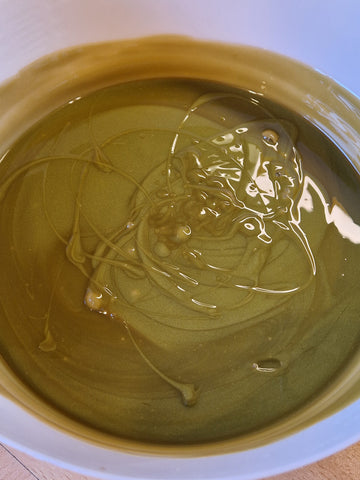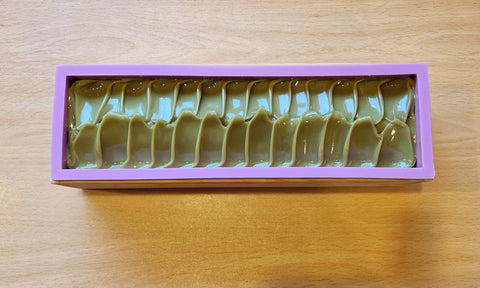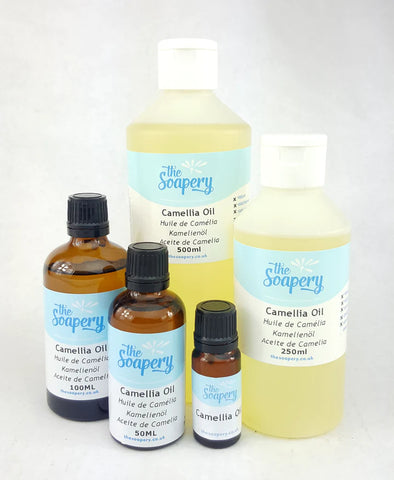Green Tea Cold Process Soap Recipe

Do you love the zingy freshness of green tea? We've taken that and turned it into a cold process soap!
With skin softening natural ingredients, a creamy lather and added essential oils for a beautiful herbal aroma this green tea cold process soap recipe is a winner every time.
This cold process soap is perfect for our silicone soap moulds to create a more unique look!
Why use green tea in soap?
Instead of just using water like you would in a normal cold process soap recipe, we've stepped up the game and replaced it with a green tea infusion!
Green tea is packed with antioxidants, B vitamins, minerals and of course, some caffeine and tannins. You'll hear antioxidants referenced a lot in anti-ageing skin creams as they help disperse free radicals which are pesky things that speed up the ageing process of the skin, so having these in a soap is great for your skin.
The vitamins and minerals in green tea that are supportive for healthy skin include vitamin E for softness and to help promote the creation of new skin cells, vitamin B2 to keep skin firm and youthful and vitamin K to help lighten dark areas. While the caffeine and tannins in the tea can help reduce puffiness and dark circles.
Why do I need to add mica powder and what is it?
Mica is a naturally occurring mineral found in rocks all over the world. These small, shiny flakes from the rocks are then ground down to form mica powder. This powder looks like a fine glitter and comes in a wide range of colours and effects which make great natural colourants.
We have added pistachio green mica powder to our green tea cold process soap recipe as the mixture will otherwise turn brown and we like the finished soap to have an attractive green colour to reflect the ingredients!
Why use camellia oil?
Camellia oil is also known as tea seed oil - it comes from the same plant that makes tea so it goes perfectly in this recipe! We've used it in place of the olive oil that you normally find in soap recipes.
Camellia oil is a great moisturizer for the skin due to the high amount of fatty acids. The fatty acids help hydrate the skin as it reduces water loss, leaving the skin feeling nourished and soft.
When camellia oil is used in cold process soap making it contributes to the conditioning effect of the soap, and adds a little hardness to the bar.
Let's have a go at our green tea soap recipe...
Makes 9-10 bars of soap
Takes 1 hour making time and 4-6 weeks curing time
Equipment:
To make our green tea cold press soap recipe, you will need:
- Gloves
- Goggles
- Digital scales
- Digital thermometer
- Stick blender
- Soap mould or DIY alternative
- Silicone spatula
- Heatproof bowl
- Plastic measuring jugs, ideally 2x 1L and 1x 2L
Ingredients:
- Water 240g
- Green tea bags x2
- Sodium hydroxide 112g
- Camellia oil 400g | 438ml
- Cocoa butter 144g
- Coconut oil 200g
- Castor oil 40g | 42ml
- Beeswax | 16g
- Pistachio green mica powder 3g
- Eucalyptus essential oil 13g | 14ml
- Lavender essential oil 13g | 15ml
- Amyris essential oil 9g | 9ml
Method:
1. Make the green tea infusion
- Boil the kettle
- Weigh the boiling water
- Add the green tea bags
- Leave to infuse overnight

2. Mix the sodium hydroxide solution
- Put your gloves and goggles on.
- Open the window, the fumes are unpleasant.
- Weigh the sodium hydroxide
- Weigh the water
- Add the sodium hydroxide to the water, not the other way around
- Mix well until combined. Careful, it will get hot!
- Leave to cool

3. Weigh and heat the oils
- Weigh the camellia oil, castor oil, cocoa butter, beeswax and coconut oil into a heatproof bowl.
- Heat gently above a pan of boiling water, or using short bursts in the microwave.
- Stir regularly until completely melted.
- Once melted, leave to cool.
- In a separate jug weigh the essential oils.
-
Weigh the green mica powder and mix it into the essential oils

4. Test the temperatures
- Test the temperature of the sodium hydroxide solution. It should be between 25C and 40C.
- Leave it to cool if necessary, but don't reheat it if it's too cool.
- Test the temperature of the melted oils. They should be between 35C and 40C.
- Leave it to cool or reheat if necessary.
- Once the temperatures are correct, add the sodium hydroxide solution to the oil mixture.

5. Blend until trace
- Mix with the stick blender and blend with short bursts.
- Watch for the mixture starting to thicken.
- Test for trace by dripping soap batter on the surface of the mixture. If the drips sit on the surface then your mixture has reached trace.
- When your soap has reached a light trace, add the essential oils.
- Mix and blend until combined

6. Pour into moulds
- Pour the soap mixture into moulds
- Tap the mould to get rid of air bubbles
- Leave on a flat surface for 48 hours before unmoulding

7. Unmould and cure
- Take your soap out from the mould
- Put the bars with gaps in between them, and leave to cure for 4-6 weeks.
Continue Reading:
Now you've learned how to make homemade green tea cold process soap, why not continue reading?
- Love the refreshing combo of citrus and mint? Why not try our Cucumber & Mint Soap Recipe?
- Been wondering if eucalyptus oil can help your hair care? We've taken a deep dive and looked at the science in our blog Eucalyptus Oil For Hair - Does It Work?
- Just starting out in soap making? Hot process soap making can be a little more forgiving for beginners. Try our Hot Process Oatmeal Soap Recipe
Did you try our green tea soap recipe? Let us know in the comments below!



Comments
Helen W said:
Really like the sound of this recipe- may have to give it a try!!
TheSoapery said:
We found it made a lovely bar of soap. If you try this recipe, be sure to let us know your feedback!